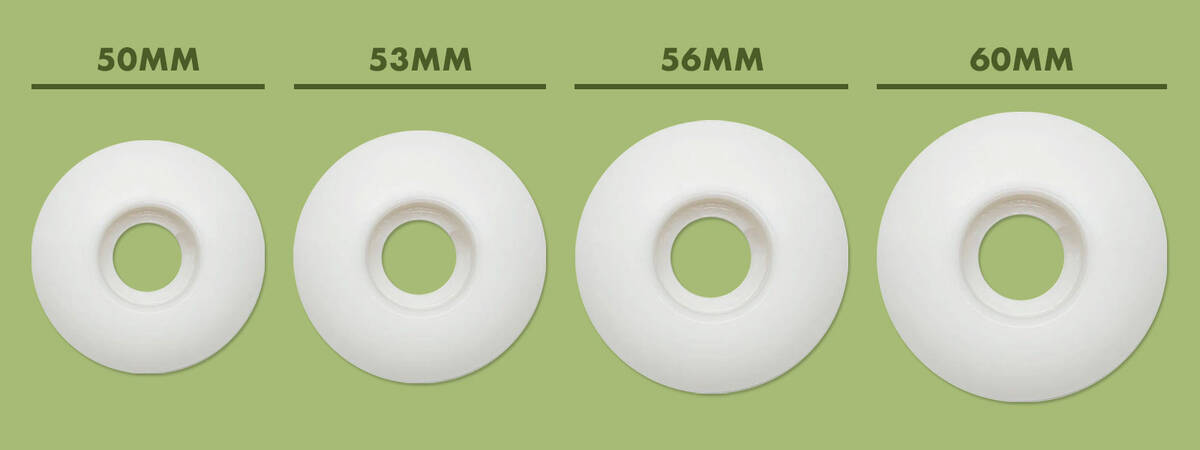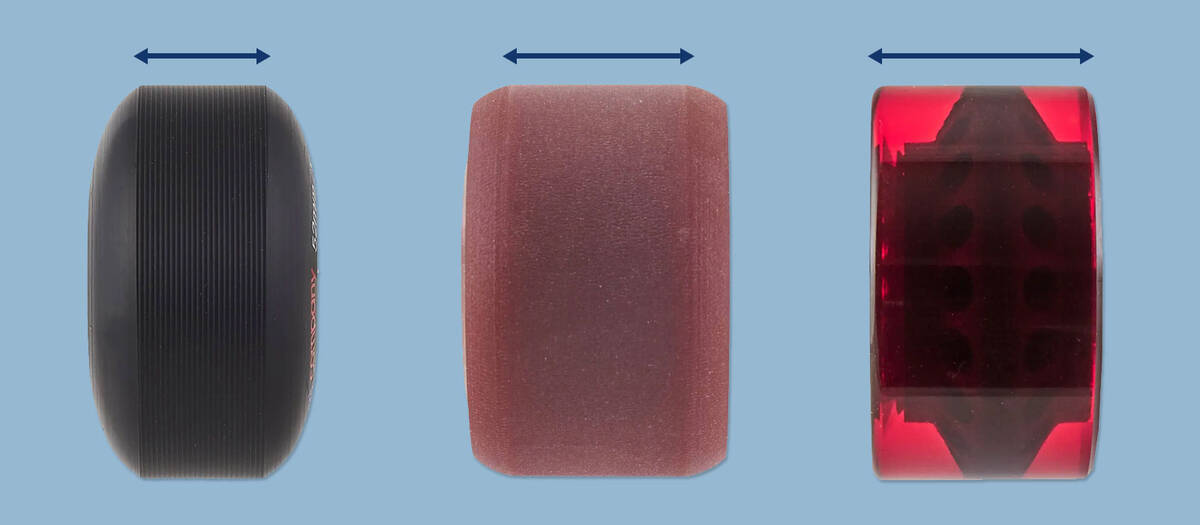Comprehensive Guide to Purchasing Skateboard Wheels
Whether you're just starting or you're a seasoned pro, skateboard wheels are a critical component of your performance. They significantly impact your skateboarding experience, and changing the type of wheel can fully revamp your skateboard setup. Hence, considering different options while choosing skateboard wheels is a sensible approach.
This guide is designed to offer you guidance in finding new skateboard wheels. Simply review the sections listed below and proceed to the part that interests you, enabling us to assist you in selecting the optimal wheels for your skateboard.
Overview
Overview
Selecting the Right Skateboard Wheels

Size and hardness are the primary considerations when picking skateboard wheels for your setup. Choosing the correct size is essential to avoid problems like wheel bites.
Besides size and hardness, factors such as shape impact the contact patch (the wheel area touching the ground), and wheel material affects grip, rebound, and weight.
Your personal preferences and riding style should lead your selection throughout the process. Ultimately, the best skateboard wheels accommodate your preferences and style, ensuring the most enjoyable experience, whether you're just starting or have been skating for years!
Continuing on, you’ll find detailed tips for selecting the best skateboard wheels tailored to your requirements.
Understanding Skateboard Wheel Sizes

Skateboard wheel sizes are gauged by diameter, and this dimension crucially influences speed, acceleration, and agility.
A more agile and technical skater often favours smaller wheels, while larger wheels suit cruising or vert skating. Here are typical distinctions between larger and smaller skateboard wheels:
Smaller wheels:
- Offer agility and manoeuvrability, great for tricks. While they might not reach speeds as high as larger wheels, they provide more responsiveness.
- Greater likelihood of sudden stops if encountering a small obstacle.
- Lower effort needed for flip tricks and popping ollies due to a mellower pop-angle.
- Work well with low trucks, allowing for a lower centre of gravity.
Larger wheels:
- Achieve higher speeds, though they have slower acceleration and reduced agility.
- More forgiving on irregular surfaces or when encountering small pebbles.
- The steeper pop-angle offers more leverage for bigger tricks, yet requires more effort. Less agile by nature.
- Higher trucks or riser pads might be necessary to prevent wheel bites.
Wheel sizes from about 52-56 mm are the most prevalent. Unless heavy vert or cruising is your main focus, you’ll likely find suitable skateboard wheels within this size range.
Below is a chart for quick reference showing skateboard wheel diameters and typical disciplines relevant to each size.
| Size | Size in mm | Recommended for |
| Medium-sized wheels | 50-53 mm | Street, park |
| Medium-sized wheels | 53-56 mm | Street, park, bowl, mini ramp |
| Large wheels | 56-60 mm | Cruising, vert |
Filter our skateboard wheel selection by diameter to discover the wheels suited for your requirements:
Skateboard Wheel Hardness and Durometer Scale
Skateboard wheel hardness is indicated on the durometer scale with a number followed by an A. For instance, 100A wheels are harder than 99A. In some cases, a B replaces an A in the durometer reading, reducing the A-scale by 20 units. For example, 83B wheels are equivalent to 103A.
When deciding whether to switch to harder or softer skateboard wheels than you currently use, consider the following guidelines:
Harder wheels
- Provide greater speed and durability
- Less grip and shock absorption
- Rattle and noise on rough surfaces
- Deliver responsiveness and rapidity on smooth surfaces
- Ideal for tricks in streets or skateparks
Softer wheels
- More grip but lesser speed and longevity
- Absorb vibrations and irregular surfaces
- Reduce noise and vibrations in skateboard filming wheels
- Ideal for cruising on various surfaces
| Hardness | Durometer | Recommended usage |
| Very soft wheels | 78A - 90A | Cruising, filming, commuting, beginners |
| Medium soft wheels | 90A - 97A | Cruising, rough surfaces, commuting, beginners |
| Medium hard wheels | 97A - 99 | Street skating, mini ramps, skateparks |
| Hard wheels | 99A + | Technical skateboarding |
To ensure you find wheels that suit your needs, filter our selection based on wheel hardness and other key specifications:
Skateboard Wheel Shape - Contact Patch & Lip Form

The key aspect when it involves skateboard wheel shapes is the contact patch, the ground-contacting part of the wheel while skating.
A narrower contact patch increases responsiveness, minimizes friction, and enhances susceptibility to sliding, benefiting blunt slides. Slim skateboard wheels direct weight onto a smaller area, amplifying vibrations on uneven surfaces. Moreover, narrower wheels weigh less due to reduced sidewall material.
Conversely, a broader contact patch promotes grip and stability, reducing slide simplicity. However, wider contact patches result in less responsive, heavier wheels.
A rounded lip shape eases transitions by allowing smoother roll over copings and avoiding hang-ups.
Wide contact patch:
- Offers more grip and stability
- Easy slide resistance
- Less responsive
- Greater weight in wider wheels
Slim contact patch:
- Enhanced responsiveness
- Decreased friction
- Simpler sliding
- Pronounced vibrations from rough surfaces
- Slimmer wheels are lighter
Comprehensive Overview of Skateboard Wheel Composition
Skateboard wheels, typically made of polyurethane, see manufacturers continually innovating urethane blends to enhance performance. Adjusting the urethane mix can alter a wheel's hardness, durability, smoothness, bounce, and sliding attributes.
Resilience and Bounce of Skateboard Wheels (Urethane Characteristics)
The skateboarding world was revolutionized with the debut of urethane skateboard wheels, replacing their former metal or ceramic counterparts. These urethane wheels introduced a crucial quality: bounce. Upon impact with a hard surface, they momentarily deform but quickly return to their original shape, imparting a bounce that transformed the skateboarding landscape.
Strict production standards, such as PU formulas, molding methods, and curing temperatures, dictate skateboard wheel quality. While primary concerns may include size, hardness, and shape, the refinement of PU formulas and production techniques greatly influences wheel quality. Choosing high-calibre wheels from reliable brands is advisable.
Optimal Skateboard Wheels for Park
For optimal park skating, skateboard wheels should be small to medium-sized (about 50-56 mm) with a hardness level (durometer) between 99A and 101A. This ensures smooth and responsive performance on smooth surfaces. A rounded shape enhances manoeuvrability for tricks and transitions, while reliable polyurethane construction guarantees durability and grip in bowls and ramps.
Ideal Skateboard Wheels for Street
Street skateboarding calls for small to medium-sized wheels (50-56 mm) with a durometer between 97A and 101A for maximum responsiveness and management on rough urban landscapes. A broader contact patch ensures stability for tricks like slides and grinds, while a conical or rounded form allows swift acceleration and agility. High-grade polyurethane is crucial for durability and a trusty grip on both asphalt and concrete.
The above advice pertains to street skateboarding. For leisurely street cruising, larger wheels can provide a smoother ride on rougher terrains. Softer wheels than 97A (ranging from 78A - 85A) are preferable if you solely cruise.
